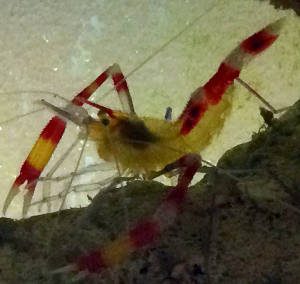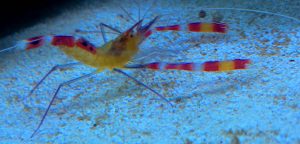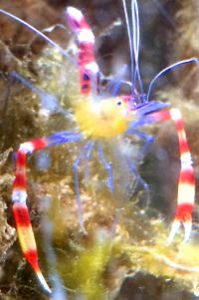
Stenopus hispidus
.
| Difficulty | Easy |
| Minimum Tank Size | 20 Gallons |
| Diet | Carnivore |
| Water Parameters | 72-78 F, pH 8-8.4, Salinity 1.020-1.025 |
| Aggression | Semi-Aggressive |
| Size | 2-4" |
The Coral Banded Shrimp, also known as the boxing shrimp, brings a lot of personality, and tension, to saltwater tanks. They are reef safe, with the rare exceptions poking at anemones.
These shrimp are generally peaceful, however they will swing their claws at passing fish and can attack other shrimp. Only keep other shrimp when they are healthy and well acclimated before adding the Coral Banded.
Diet & Feeding
Coral Banded Shrimp are carnivores with a scavenger mentality. While they do prefer live foods, they are not opposed to eating normal flake or pellet foods. In fact many stores will sell shrimp specific pellets which sink quickly and attract the shrimp.
When feeding your fish/CBS you will need to watch the shrimp and be sure he is getting food. If the shrimp does not get any prepared foods he will search for food elsewhere. This can be anything from leftover food stuck on the rocks or sand to living creatures. Typically they will be scared away by most any fish or crab, however they can pick on snails, hermit crabs and other shrimp. I discovered this when adding Peppermint Shrimp to my tank to remove aiptasia. One of the shrimp was not as well acclimated and spent long stretches of time sitting still. The next day there was only one peppermint remaining, with the Coral Banded Shrimp hiding for the next few days due to his large meal.
This brings us back to the shrimp pellets. When using these be extra sure the Coral Banded Shrimp gets his own pellet. Mine has taken a few swings at the cleaner shrimp when he fails to get his own pellet. Thankfully most shrimp are much faster than the coral banded, allowing them an easy escape.
Aggression

A Coral Banded Shrimp running across the sandbed.
While menacing in appearance, the Coral Banded Shrimp will rarely harm other livestock. Still they are opportunistic feeders and can ambush slow moving inverts. As a mandarin keeper, which bury themselves for the night, I have never seen aggression from the Coral Banded Shrimp. I am sure he has found them, as I watched him run his antenna across the mandarins head multiple times before moving on.
Some of their aggression ties into their diet, so be sure to read that section as well to learn about the coral banded shrimps aggression.
Breeding & Sexing

A male Coral Banded Shrimp.
The Coral Banded Shrimp has two main differences between males and females. First off the male is much smaller than the female. When you visit your local fish store and see the monster sized CBS, they are likely females.
The second, and much more reliable way, to tell gender is looking at the bottom of their body, where their legs connect to their torso. Females will have blue/green areas here. These are their ovaries. If you are unsure which gender you have you can wait for the shrimp to molt. Right after molting the colors are much more obvious. No blue/green means it’s a male.
Failing to identify the gender and getting two same sex shrimp will result in the death of one of the shrimp. It’s only a matter of time before the larger ambushes the smaller.
Keeping a single pair of coral banded is perfectly acceptable, however you cannot add more of either gender. Likewise do not add any other variant of the Coral Banded Shrimp. While they may not be the same they will still fight each other.
Breeding these shrimp is nearly impossible. The reproduce much like peppermint shrimp, however they release far smaller, but more numerous batches of eggs. To have any from of success you will need to place the shrimp in a kreisel. This will keep the eggs suspended for their growth period, however the success rate is abysmal. Still, making even one or two new Coral Banded Shrimp feels absolutely amazing.